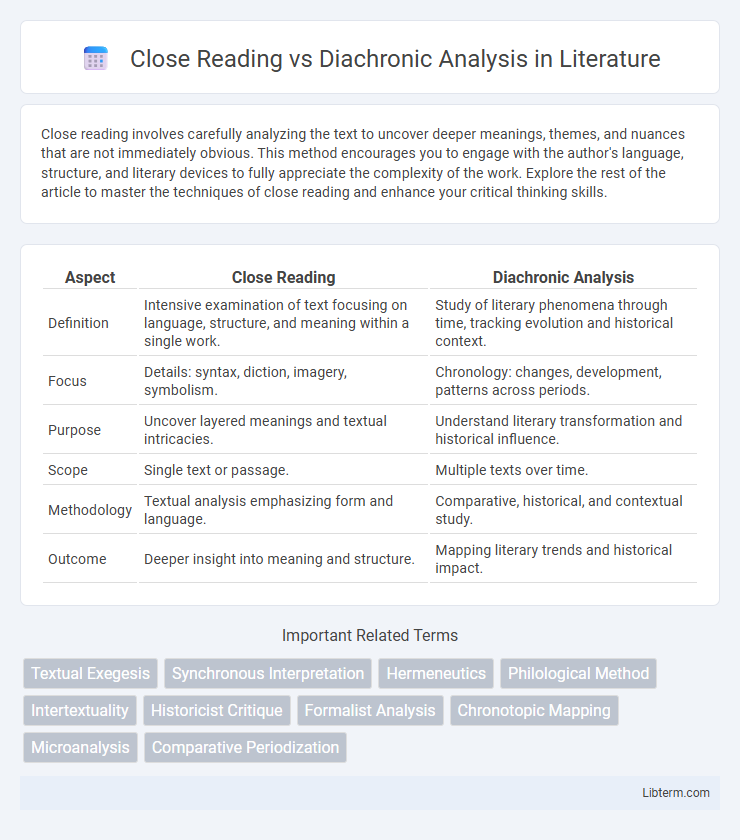Close reading involves carefully analyzing the text to uncover deeper meanings, themes, and nuances that are not immediately obvious. This method encourages you to engage with the author's language, structure, and literary devices to fully appreciate the complexity of the work. Explore the rest of the article to master the techniques of close reading and enhance your critical thinking skills.
Table of Comparison
| Aspect | Close Reading | Diachronic Analysis |
|---|---|---|
| Definition | Intensive examination of text focusing on language, structure, and meaning within a single work. | Study of literary phenomena through time, tracking evolution and historical context. |
| Focus | Details: syntax, diction, imagery, symbolism. | Chronology: changes, development, patterns across periods. |
| Purpose | Uncover layered meanings and textual intricacies. | Understand literary transformation and historical influence. |
| Scope | Single text or passage. | Multiple texts over time. |
| Methodology | Textual analysis emphasizing form and language. | Comparative, historical, and contextual study. |
| Outcome | Deeper insight into meaning and structure. | Mapping literary trends and historical impact. |
Introduction to Close Reading and Diachronic Analysis
Close reading involves a detailed, line-by-line examination of a text to uncover meanings, themes, and stylistic devices within its immediate context. Diachronic analysis traces the evolution of language, concepts, or texts over time, emphasizing historical development and change. These methods complement each other by providing both micro-level close textual insights and macro-level temporal perspectives.
Defining Close Reading: Focus on Textual Detail
Close reading involves meticulous attention to textual detail, emphasizing the interpretation of language, structure, and literary devices within a fixed text. This method prioritizes understanding meaning by analyzing word choice, syntax, and symbolism without considering historical or external contexts. Close reading sharpens comprehension and uncovers deeper layers of significance embedded in the text itself.
Understanding Diachronic Analysis: Tracing Text Over Time
Diachronic analysis examines texts by tracing their evolution and variations across different historical periods, uncovering shifts in language, meaning, and cultural context. This method contrasts with close reading by prioritizing temporal changes and continuity within a text, revealing how interpretations transform over time. By integrating linguistic and historical data, diachronic analysis provides a dynamic perspective on textual development and its sociocultural significance.
Historical Context of Both Methods
Close reading emphasizes detailed textual analysis, focusing on language, structure, and meaning within a single work, often independent of historical background. Diachronic analysis investigates texts over time, exploring linguistic, cultural, and historical changes to understand evolution and context. The historical context in close reading is minimal, while diachronic analysis integrates historical shifts to reveal broader trends and transformations.
Key Objectives and Approaches Compared
Close reading emphasizes detailed examination of a single text's language, structure, and meaning to uncover deeper interpretations and nuances. Diachronic analysis tracks changes in language, themes, or cultural contexts across different time periods to understand evolution and historical development. The key objective of close reading is to reveal intrinsic textual intricacies, while diachronic analysis aims to highlight transformation and continuity over time.
Strengths of Close Reading in Literary Criticism
Close reading excels in literary criticism by enabling precise analysis of language, structure, and literary devices within a text, revealing deeper meanings and thematic complexities. This method emphasizes attention to detail, such as symbolism, diction, and syntax, which enriches interpretation and appreciation of a work's artistic craftsmanship. Close reading also facilitates subjective engagement and nuanced understanding by focusing intensively on specific passages without the distraction of external historical contexts.
Benefits of Diachronic Analysis in Research
Diachronic analysis offers significant benefits in research by enabling scholars to trace the evolution of language, concepts, or phenomena over time, providing a dynamic understanding that close reading's static snapshot cannot capture. This longitudinal perspective reveals patterns of change, continuity, and context-specific influences critical for comprehensive historical and cultural insights. By examining shifts across periods, diachronic analysis enhances interpretive accuracy and supports the identification of trends that inform contemporary applications or theoretical developments.
Common Challenges and Limitations
Close reading often faces challenges related to subjective interpretation and limited scope, which can restrict analysis to minute textual details without considering broader historical context. Diachronic analysis encounters limitations in tracing language evolution due to incomplete historical data and difficulties in accounting for diverse linguistic influences over time. Both methods require balancing detailed examination with contextual understanding to avoid skewed or fragmented insights.
Choosing the Right Method for Your Study
Close reading emphasizes detailed examination of a specific text's language, structure, and meaning, ideal for in-depth literary analysis focused on particular passages. Diachronic analysis traces changes and developments across time, making it essential for historical linguistics, cultural studies, and understanding evolution in language or themes. Selecting the right method depends on whether the study aims to analyze a single text's nuances or investigate transformations within texts, languages, or concepts over periods.
Integrating Close Reading and Diachronic Analysis
Integrating close reading and diachronic analysis enhances literary interpretation by combining detailed textual examination with historical language evolution and contextual shifts. Close reading identifies nuanced linguistic features and thematic elements, while diachronic analysis traces changes across time periods, enriching understanding of meaning and authorial intent. This interdisciplinary approach leverages philological insights and textual microanalysis to produce comprehensive, temporally informed interpretations.
Close Reading Infographic

 libterm.com
libterm.com